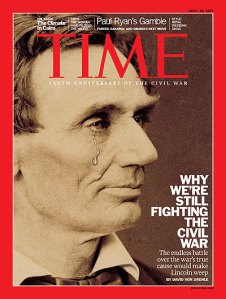
|  | | LINCOLN PHOTOGRAPH FROM THE AMERICAN ANTIQUARIAN SOCIETY/BRIDGEMAN ART LIBRARY. TEAR BY TIM O'BRIEN |  | | The April 18, 2011, cover of TIME |  |  | |
“Slavery, as many have noted, was America's original sin. The Framers made an ugly compromise to ratify the Constitution, many of them knowing that the seed of disunion had been planted even as the Republic was born. Lincoln regarded the Declaration, not the Constitution, as the moral template for America, and even though he was not an extreme abolitionist, he saw "all men are created equal" as the vision statement for the nation. He knew and wrote that the Civil War would not have happened except for slavery. On the 150th anniversary of the war, David Von Drehle's powerful cover story makes clear that "forgetting was the price of reconciliation."… It was easier for survivors, and later for entire schools of historians, to frame the war in terms of a conflict over trade or states' rights than to face the terrible legacy of slavery on both sides of the Mason-Dixon Line.”
|

